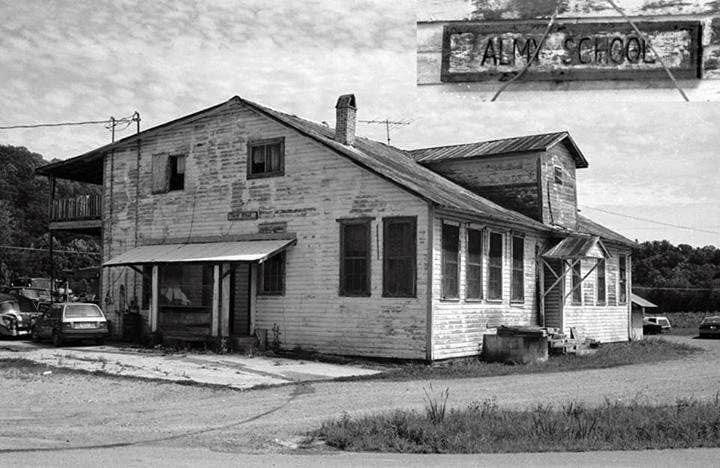You’re reading “Echoes in Time,” a weekly newsletter by the Independent Herald that focuses on stories of years gone by in order to paint a portrait of Scott County and its people. “Echoes in Time” is one of six weekly newsletters published by the IH. You can adjust your subscription settings to include as many or as few of these newsletters as you want. If you aren’t a subscriber, please consider doing so. It’s free!
Today’s newsletter is sponsored by the Scott County Chamber of Commerce. Since 1954, the Scott County Chamber of Commerce has advocated for a strong community by supporting stronger infrastructure and leadership.
Ever wondered why Paint Rock was once known as Almy?
Paint Rock Creek begins as a small trickle of water near Tunnel Hill, east of Oneida. From there, it rolls through Sugar Camp Hollow, merging with Cherry Fork Creek and several smaller, unnamed streams before eventually merging with Stanley Creek and flowing on to New River, where it empties just outside Huntsville, at a place the locals once called River Junction.
The community that sprawls through the fertile valley carved by this stream takes its name from the creek itself — Paint Rock. But there was a time when this community was also known as Almy. That was the name of the school that was situated along present-day S.R. 456 near where Stanley Creek and Paint Rock Creek merge (which came to be known as Stanley Junction after the Paint Rock Coal & Coke Co. Railroad was built in the 1890s). Did you ever wonder why? Here’s the answer.
Like many communities in Scott County, Almy got its name from the post office that served the community. And the post office got its name from its postmaster. Sometimes the names stuck. Sometimes they faded after the post offices had closed. Examples of the latter include Cortland (which the area around Lone Mountain near the top of Brimstone was once called), Elva (No Business and Station Camp), and Hughett (Slick Rock on Brimstone). Add Almy to the list. “Old-timers” fondly remember the days when the area around where Tunnel Hill Road and Paint Rock Road intersect was known as Almy. But for most folks, and on almost any map, this area is now known simply as “Paint Rock.”
It was in September 1890 that the first post office opened on Paint Rock Creek. The postmaster was a man named Adrian Almy. And that’s how the name “Almy” came to be … and lasted even long after Adrian Almy had moved away from Scott County. But who was this man, and how did he wind up at Paint Rock?
Adrian Adelbert Almy was born March 1850, the son of Samuel Willett Almy (1821-1899) and Sally Foster Applebee (1823-1864) of New York. He was one of four children living in his parents’ home when the New York State census was taken in 1855. His parents employed a servant named Anna Taylor, indicating that they were relatively wealthy. In 1871, Almy was listed as a student at Alfred University in New York. After his studies, he married Mary Emma Darrow (1852-1944) from Connecticut, and they had two children: Samuel Willett Almy, born in 1880, and Edmund Darrow Almy, born in 1885. The year his second son was born, Adrian was listed on the board of supervisors in Allegany County, N.Y.
Like the community of Almy that would come to bear his name, Adrian Almy wound up on Paint Rock Creek because of the fledgling coal and coke industry that was springing up there … and that industry came about because of the brand-new Cincinnati-Southern Railroad that was built through Scott County in the 1870s.
The railroad, built by the city of Cincinnati to link itself to Chattanooga, opened Scott County’s rich coal and timber reserves to outside investors. In time, seven different short-line railroads sprang up in Scott County — more than any other county along the Southern Railroad route. Investors eager to make a buck discovered coal (or timber) at Helenwood, all along New River, Glenmary, and elsewhere … including Paint Rock Creek.
History books tell us that a “Dr. Gruno” who was a Union physician during the Civil War and served as a surveyor on the Southern Railroad was the person who discovered large coal deposits along the headwaters of Paint Rock Creek. Nothing else is known about this mysterious Dr. Gruno. But, apparently, he brought investors that included a W.M. Appelby (or Applebee) and Robert Hibbler to Scott County to form the Paint Rock Coal & Coke Company. The company almost immediately began construction of a short-line railroad from the Oneida station to Morning Glory, which would come to be known as Stanley Junction. Along the way, they dug the 402-foot-long tunnel in the area of Paint Rock Creek’s headwaters that would come to be known as Tunnel Hill.
In 1902, the Paint Rock Coal & Coke Co. was sold to investors from New York, and the railroad sold again to Samuel Spencer in 1905. The railroad was eventually extended from Morning Glory along Paint Rock Creek to New River, and along New River into Anderson County. It was named the Tennessee Railroad.
Before all of that, though, Adrian Almy moved from New York to Paint Rock Creek to work for the Paint Rock Coal & Coke Co.’s railroad. A newspaper would write years later that he left New York in 1889. Construction of the eventual Tennessee Railroad into Paint Rock began that same year. Based on Almy’s later activities, we can reasonably assume that he worked as a purchasing agent to buy land for the railroad. Ironically, as controversy swirls today over a proposed recreational trail along the former railroad route and whether the right-of-way for the railroad was purchased fee simple or as a temporary easement, it might have been Almy who negotiated many of those sales. It appears likely that W.M. Applebee, one of the founders of the Paint Rock Coal & Coke Co., was related to Almy’s mother.
It was in September 1890 that the Almy Post Office opened at Paint Rock, with Almy serving as the postmaster. It was very common practice for new post offices to take on the names of their postmaster. It was also common for communities to take on the names of their post offices, which is why the school at Paint Rock was later named Almy Elementary School. For many years, Huntsville Hill Road, which leads over the mountain from Paint Rock to Huntsville, was named Old Almy Road. That name can still be found on some atlases.
It is perhaps ironic that Almy was only in Scott County a very short period of time. The name of the community that was growing around the coal mines and the railroad far outlived his stay here. Once the railroad was built, Almy was off to serve in other ventures.
By the time the 1900 census was taken, Almy lived in Altamont, Ky., a small coal town just north of London. The town was named for the Altamont Coal Company, which was established in 1882. A notice in The Frankfort Roundabout newspaper, published on March 21, 1891, stated that Almy, Andrew J. Applebee (Almy’s uncle), and S.F.J. Trabue had incorporated the Capital Mining, Lumber & Oil Company in Frankfort, Ky. So, his time in Scott County may have been very short, indeed — perhaps as little as a couple of years.
Almy was still living in the London area when the 1910 census was taken, and were raising their grandson, also named Adrian Almy, after his mother, Mary Lee Fuson, died in childbirth.
That same year, 1910, Adrian Almy moved to Deming, N.M., a small town just north of the Mexican border, to take a job with the Santa Fe Railroad. He died there on May 5, 1915, at age 65. He was buried at Mountain View Cemetery in Deming.
In time, the Almy family disappeared from history. Mary Almy died in 1944 at age 91 and was buried at Mountain View Cemetery with her husband. Samuel Willett Almy died of a heart attack in Texas in 1948 at age 67 and was buried at the same cemetery as his parents. Edmund Almy died in 1956 at age 71 and was buried at the U.S. Naval Academy Cemetery in Maryland. He served as a captain in the Navy during World War I. Adrian Almy, the grandson who lived with Adrian and Mary Almy in 1910, died in 1993 in Carlsbad, N.M. after spending his career as a mining engineer.
Back on Paint Rock Creek in Scott County, there were far more prominent families that emerged — none moreso than the Sexton family (descended from Caswell Sexton and Rachel Cecil), but there were others.
As for the Almy Post Office, it closed in August 1909 and postal operations there moved to Oneida. The last postmaster was James D. Roberts. And still the name “Almy” lived on, for many years to come. All because of a businessman named Adrian A. Almy who moved from New York to Paint Rock Creek in 1889 and helped purchase land for the railroad that would be built through the valley.
Thank you for reading. Our next newsletters will be Threads of Life on Wednesday and The Weekender Thursday evening. Want to update your subscription to add or subtract these newsletters? Do so here. Need to subscribe? Enter your email address below!
◼️ Monday morning: The Daybreaker (news & the week ahead)
◼️ Tuesday: Echoes in Time (stories of our history)
◼️ Wednesday: Threads of Life (obituaries)
◼️ Thursday evening: The Weekender (news & the weekend)
◼️ Friday: Friday Features (beyond the news)
◼️ Sunday: Varsity (a weekly sports recap)




